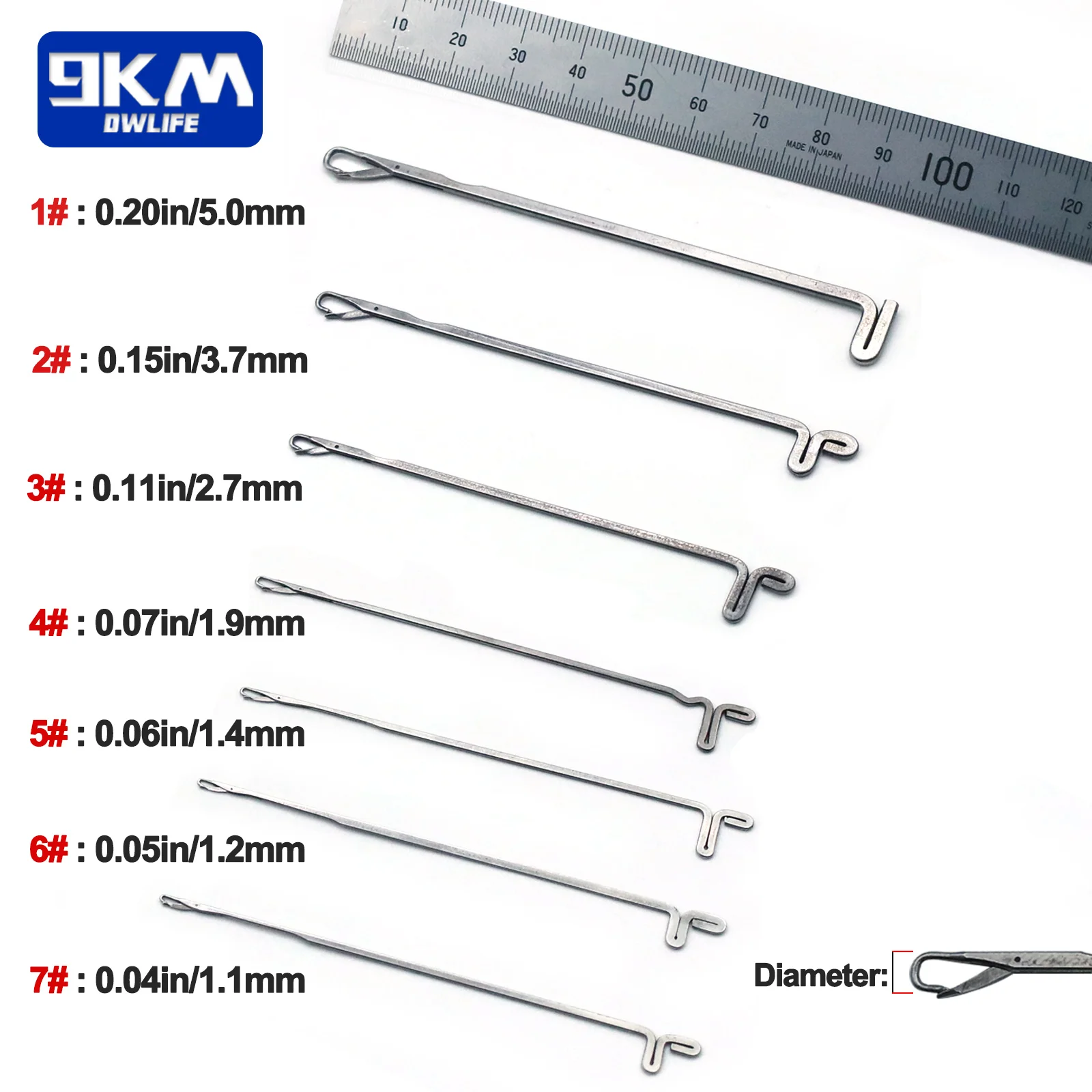9km-dwlife
7Pcs Reverse Latch Needle Fishing Assist Cord Fishing Rigging Needle Fishing Accessories Ring Splicing Jigging Setup Wig Weaving
7Pcs Reverse Latch Needle Fishing Assist Cord Fishing Rigging Needle Fishing Accessories Ring Splicing Jigging Setup Wig Weaving
Verfügbarkeit für Abholungen konnte nicht geladen werden
7Pcs Reverse Latch Needle Fishing Assist Cord Fishing Rigging Needle Fishing Accessories Ring Splicing Jigging Setup Wig Weaving
Si
1# Diameter: 0.20in/5.0mm Length: 3.86in/9.8cm 2# Diameter: 0.15in/3.7mm Length: 3.46in/8.8cm 3# Diameter: 0.11in/2.7mm Length: 3.15in/8.0cm 4# Diameter: 0.07in/1.9mm Length: 3.15in/8.0cm 5# Diameter: 0.06in/1.4mm Length: 3.15in/8.0cm 6# Diameter:0.05in/1.2mm Length:3.15in/8.0cm 7# Diameter: 0.04in/1.1mm Length: 3.15in/8.0cm

Description
It is mainly used for the splicing and production of fishing assist lines, which can make fishing assist hooks without knots, enhancing aesthetics while greatly reducing the risk of line breakage due to friction of the bulky connection.
 When the fishing assist cord wears and breaks after long-term use, of course, you can't just throw it away, start to repair your hooks with DIY! 9KM DWLIFE reverse latch needle tool set is sure to be a good companion on your long fishing trip.
When the fishing assist cord wears and breaks after long-term use, of course, you can't just throw it away, start to repair your hooks with DIY! 9KM DWLIFE reverse latch needle tool set is sure to be a good companion on your long fishing trip.

The front end of the reverse latch needle is a holder that can be opened and closed at will, which can firmly fix one end of the rope when splicing the rope, making your production easier.The end of the needle is designed to prevent the entire needle from sinking into the cord and causing the production to fail.

Precision rigging needle, available in a total of 7 different sizes, to meet your requirements for making different rope applications. Please refer to the size details to choose the appropriate size.

Wide range of applications: In addition to making assist hook, reverse latch needles can be used in the treatment of various ropes. Such as bracelet weaving, Stringing Beads, necklace making, wig weaving,Woolen Knitting,etc.

How to choose the right size? Please measure your rope diameter, then check our size chart and choose a reverse latch needle with a diameter slightly larger than the rope diameter. What kind of line is suitable for? If you need to splice line, you will need to use a hollow braided construction line. Note: Since the material of the reverse latch needle is alloy, please wipe off the moisture and dirt on the surface after use to prevent the reverse latch needle from rusting.
 Advantages of DIY making fishing assist hook: 1. After long-term use, the assist line will inevitably be worn and broken. Using the reverse latch needle to repair the fishing assist hook will greatly save your expenses. 2. The traditional method of tying knots on fish hooks not only looks bulky, but also the raised knots are more prone to breakage. Using rigging needle to create a knotless fishing assist line will effectively avoid these problems.With loop stitching, the 9KM DWLIFE needle creates a very aesthetically pleasing secondary hook setting and terminates the solid loop with the slimmest profile. 3.The auxiliary fishing line made by splicing will be stronger and the action of the fake bait will be more flexible, greatly improving the chances of successful fishing and enhancing efficiency! 4.Every angler has his or her own idea of tackle, and some commercially produced auxiliary hooks may not be suitable for everyone. So make your own unique fishing auxiliary hooks according to your needs!
Advantages of DIY making fishing assist hook: 1. After long-term use, the assist line will inevitably be worn and broken. Using the reverse latch needle to repair the fishing assist hook will greatly save your expenses. 2. The traditional method of tying knots on fish hooks not only looks bulky, but also the raised knots are more prone to breakage. Using rigging needle to create a knotless fishing assist line will effectively avoid these problems.With loop stitching, the 9KM DWLIFE needle creates a very aesthetically pleasing secondary hook setting and terminates the solid loop with the slimmest profile. 3.The auxiliary fishing line made by splicing will be stronger and the action of the fake bait will be more flexible, greatly improving the chances of successful fishing and enhancing efficiency! 4.Every angler has his or her own idea of tackle, and some commercially produced auxiliary hooks may not be suitable for everyone. So make your own unique fishing auxiliary hooks according to your needs!
 Fishing assist line production process: Step 1 - Remove the inner core from the assist line (you can start making it if you don't have one). Keeping the front end retainer open, thread the needle through the middle of the rope. Step 2 - Thread the needle through the middle of the string until the retainer at the front of the needle is also exposed. Step 3 - After threading the solid loop from one end of the rope, clamp one end of the rope with the needle holder. Step 4 - Pull the end of the needle until the splicing is complete, finally finishing the line and you're done!
Fishing assist line production process: Step 1 - Remove the inner core from the assist line (you can start making it if you don't have one). Keeping the front end retainer open, thread the needle through the middle of the rope. Step 2 - Thread the needle through the middle of the string until the retainer at the front of the needle is also exposed. Step 3 - After threading the solid loop from one end of the rope, clamp one end of the rope with the needle holder. Step 4 - Pull the end of the needle until the splicing is complete, finally finishing the line and you're done!

Share












